History, Art & Culture: February 2024 Current Affairs | General Test Preparation for CUET UG - CUET Commerce PDF Download
Maratha Military Landscapes
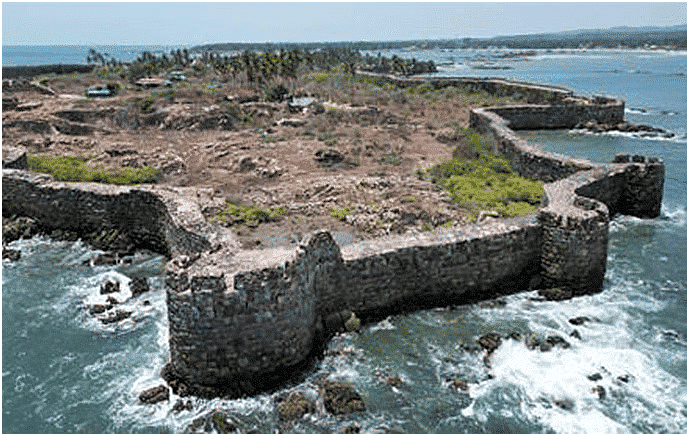
Overview
India is preparing to propose the "Maratha Military Landscapes" for UNESCO World Heritage recognition in 2024-25. This nomination features 12 forts and fortifications, highlighting the strategic military capabilities of the Maratha rulers in different regions.
What are the Maratha Military Landscapes?
The "Maratha Military Landscapes" encompass a network of 12 forts and fortifications, representing the remarkable military strategies of the Maratha rulers from the 17th to the 19th centuries. These sites include Salher Fort, Shivneri Fort, Lohgad, Khanderi Fort, Raigad, Rajgad, Pratapgad, Suvarnadurg, Panhala Fort, Vijaydurg, Sindhudurg in Maharashtra, and Gingee Fort in Tamil Nadu.
Background
The Maratha Military Landscapes are part of India's Tentative List for World Heritage sites since 2021. This nomination marks the sixth cultural property from Maharashtra to be proposed for inclusion in the World Heritage List.
Geographical Significance
These forts, varying in size and features, are strategically located across the Western Ghats, Konkan Coast, Deccan Plateau, and Eastern Ghats. They are a testament to the integration of landscape, terrain, and physiographic characteristics unique to these regions.
Protection Status
Out of over 390 forts in Maharashtra, only 12 are selected for the Maratha Military Landscapes, with eight under the Archaeological Survey of India's protection and four under the Directorate of Archaeology and Museums, Government of Maharashtra.
Categorization
The forts encompass various types, including hill forts, hill-forest forts, hill-plateau forts, coastal forts, and island forts.
Historical Context
The Maratha Military ideology traces back to the 17th century under Chhatrapati Shivaji Maharaj's rule and continued through subsequent rulers until the end of Peshwa rule in 1818 CE.
UNESCO World Heritage Nomination Process
The World Heritage List, administered by UNESCO, recognizes sites of outstanding universal value. Nominations must meet at least one of ten criteria, with the Maratha Military Landscapes proposed under Criteria (iii), (iv), and (vi) for cultural sites.
Savitri Bai Phule & Rani Velu Nachiyar
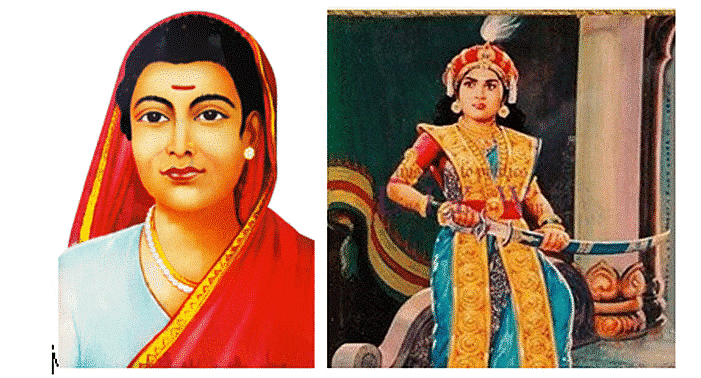
Context
The Prime Minister paid tributes to Savitribai Phule and Rani Velu Nachiyar on their Jayanti.
Details About Rani Velu Nachiyar
- Early Life and Training: Born on January 3, 1730, daughter of King Chellamuthu Vijayaragunatha Sethupathy and Queen Sakandhimuthathal of the Ramnad kingdom. Received extensive training in combat skills including weaponry, martial arts like Valari and Silambam, and proficiency in languages such as French, English, and Urdu. Married the king of Sivagangai and had a daughter.
- Conflict with East India Company: Entered conflict when her husband was killed in battle with East India Company (EIC) soldiers in 1780 at KalaiyarKoil. Fled Sivagangai as a fugitive and sought assistance from Hyder Ali. Employed guerrilla warfare tactics and formed an all-woman army known as "udaiyaal" to resist the British.
Leadership and Resistance
- Organized resistance against the British with support from feudal lords, Tipu Sultan, Marudhu brothers, Thandavarayan Pillai, and rich merchants.
- Executed a significant blow to the enemy when her commander, Kuyili, carried out a suicide attack on an EIC ammunition depot.
- Personally ran into the ammunition godown, setting herself on fire to destroy it.
Reclamation of Kingdom and Legacy
- Regained control of her husband's kingdom and ruled it for a decade.
- Passed on powers to her daughter Vellacci and Marudu brothers.
- Died on December 25, 1796, leaving behind a legacy of courage, leadership, and valiance in resisting foreign rule.
About Savitribai Phule
- Early Life: Born on January 3, 1831, in Naigaon, Maharashtra, to Lakshmi and Khandoji Neveshe Patil of the Mali Community. Married Jyotirao Phule and became an educator after being educated by him and American missionary Cynthia Farrar.
- Pioneering Efforts: Established schools for girls, campaigned against societal norms like child marriage and advocated for widow remarriage. Established the Mahila Seva Mandal and fought against caste and gender-based discrimination.
- Literary Works: Authored poems and publications emphasizing education and empowerment for the oppressed.
- Heroic End: Sacrificed her life aiding plague victims in 1897.
Kadamba Inscription
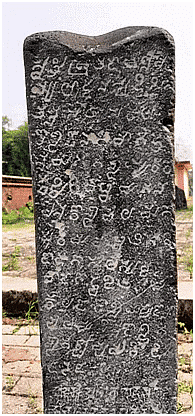
Context
The Kadamba inscription, written in both Kannada and Sanskrit, begins with the auspicious phrase "Swasthi Shri." It narrates the story of Talara Nevayya's son, Gundayya, who pledged to fulfill his father's wish of capturing a gopura in Goa's port.
- Gundayya fought valiantly but perished in achieving his father's desire. Remarkably, the inscription is crafted as a heartfelt lamentation by the grieving father, reminiscent of the literary style seen in Jayasimha I's Talangre inscription from the same era.
Key Points about the Kadambas of Goa
- The Kadambas of Goa were vassals of the Chalukyas of Kalyana.
- Chalukya emperor Tailapa II appointed Kadamba Shasthadeva as the mahamandaleshwara of Goa for his assistance in overthrowing the Rashtrakutas.
- Kadamba Shasthadeva's conquests include Chandavara in 960 A.D. and the port of Gopakapattana (present-day Goa).
- Gundayya, Talara Nevayya's son, likely participated in the battle for the port, ultimately sacrificing his life to secure victory.
Understanding Inscriptions in History
- Inscriptions serve as crucial historical artifacts, often found on stone, metal, or other materials.
- They offer valuable insights into the existence and actions of early rulers and civilizations, serving as tangible evidence of past events and societies.
Kateel Yakshagana Mela

The Karnataka High Court has allowed the century-old Kateel Durgaparameshwari Prasadita Yakshagana Mandali to resume all-night shows, adhering to noise pollution norms.
About Kateel Yakshagana Mela
- It refers to a traditional form of theater performance known as Yakshagana, which is predominantly found in the state of Karnataka, India.
- Specifically, “Kateel” refers to the town of Kateel in Karnataka, which is known for its own unique troupes or ‘Melas’ performing this art form.
- It includes stories from Hindu epics like the Ramayana and the Mahabharata.
- They are usually performed on open-air stages at night and can last up to several hours.
Back2Basics: Yakshagana
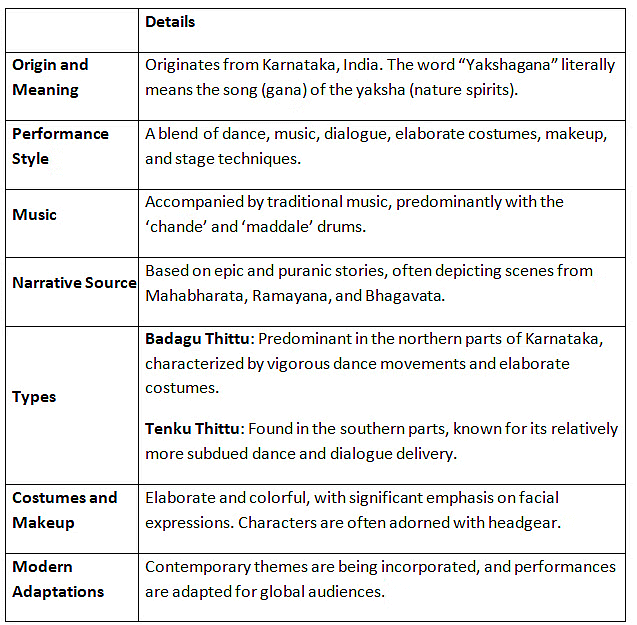
Vadnagar (Oldest Living City of India)
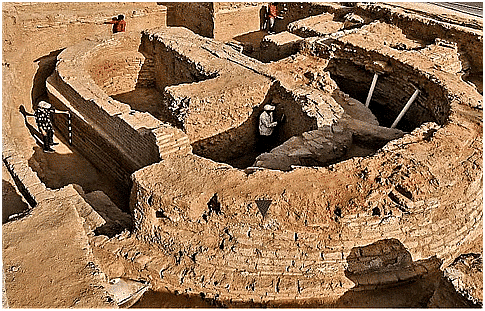
A collaborative investigation conducted by the Indian Institute of Technology (Kharagpur) and the Archaeological Survey of India (ASI) has unearthed significant evidence of uninterrupted cultural development in Vadnagar, Gujarat, following the decline of the Harappan civilization. This research fundamentally challenges the prevailing notion of a "Dark Age" in history, providing compelling evidence of sustained cultural evolution in Vadnagar.
Key Discoveries at Vadnagar
- Ancient Settlement Age: The study reveals traces of human habitation in Vadnagar dating back to approximately 800 BCE, placing it within the late-Vedic/pre-Buddhist Mahajanapadas or oligarchic republics era.
- Climate Impact: The rise and fall of various regimes over a span of 3,000 years, alongside recurrent incursions by Central Asian invaders, are proposed to be influenced by significant climatic shifts, such as fluctuations in rainfall patterns and periods of drought.
- Diverse Cultural Fabric: Vadnagar emerges as a melting pot of diverse cultural and religious influences, encompassing Buddhist, Hindu, Jain, and Islamic elements. The excavation has unveiled seven distinct cultural epochs, spanning from the Mauryan period to contemporary times under Gaekwad-British colonial rule.
- Archaeological Treasures: A myriad of archaeological artifacts, ranging from pottery to metallic objects including copper, gold, silver, and iron, have been unearthed. Noteworthy discoveries include intricately crafted bangles and coin molds attributed to the Indo-Greek epoch.
- Buddhist Monastic Presence: Among the notable findings is the identification of one of the oldest Buddhist monastic sites in Vadnagar, accentuating the historical and cultural richness of the region.
- Radiocarbon Dating Insights: Preliminary radiocarbon dating results, yet to be published, suggest a possible antiquity of the settlement dating back to around 1400 BCE. Such findings directly challenge the conventional concept of a "Dark Age" in the aftermath of the Indus Valley Civilization's collapse, suggesting a continuous cultural trajectory in India spanning over 5500 years if validated.
Chittorgarh Fort
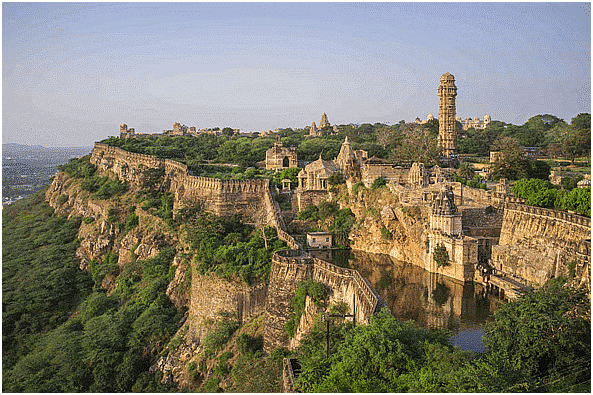
The Supreme Court recently issued directives aimed at safeguarding the Chittorgarh Fort in Rajasthan against activities involving blasting, acknowledging its historical significance and cultural heritage.
About Chittorgarh Fort
- Origin: Constructed by local Maurya rulers during the 7th century A.D., Chittorgarh Fort stands as one of India's largest forts, situated in Rajasthan.
- Historical Evolution: Tradition holds that the fort's inception is credited to Chitrangada Mori, a local Maurya ruler. Subsequently, in 728 CE, it fell under the dominion of the Mewar rulers, serving as the capital of their realm.
- Geographic Setting: Perched atop a 180-meter-high hill, overlooking the banks of the Berach River, the fort commands a strategic position.
- Historical Significance: Throughout its existence, the fort has borne witness to the valor of legendary figures in Indian history, including Badal, Gora, Maharana Pratap, Rana Kumbha, Patta, and Jaimal, among others. Recognizing its cultural importance, it was designated a UNESCO World Heritage Site in 2013.
Features
- Architectural Elements: Renowned for its seven gates, such as Padan Gate, Ganesh Gate, Hanuman Gate, Bhairon Gate, Jodla Gate, Lakshman Gate, and the principal gate named after Lord Ram, the fort's architecture was designed to fortify against enemy incursions. The gates' arches even serve the purpose of obstructing elephant entry.
- Magnitude and Layout: Spanning an expanse of 700 acres with a circumference of 13 km, the fort boasts a kilometer-long road leading to the ramparts, traversing through the seven gates. Its walls, constructed using lime mortar, tower up to 500 meters above ground level.
- Architectural Contents: Within its confines, the fort harbors four palaces, 19 temples (including Jain and Hindu), 20 water bodies, and four memorials, underscoring its rich architectural and cultural diversity.
Jauhar Mela
Cultural Tradition: Annually, the Chittorgarh Fort hosts the Jauhar Mela, commemorating one of the jauhars (mass self-immolation by women to evade capture or dishonor). While the festival doesn't bear a specific title, it is widely believed to honor Rani Padmini's jauhar and celebrate the valor of Rajputana.
Somnath: A Brief History of the Temple
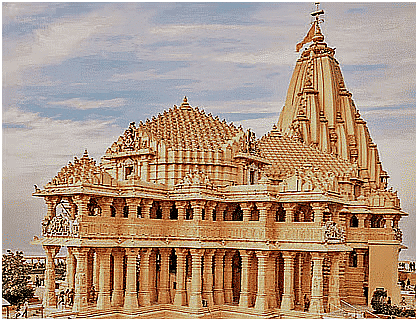
Context
The Prime Minister of India is to inaugurate the Ram temple in Ayodhya, Uttar Pradesh on 22nd January. This brought back the memory of inauguration of Somnath temple, that was 73 years ago by the then President of India, Rajendra Prasad.
- British Governor General Lord Ellenborough (1842-1844) presented the temple as a symbol of Islam’s excesses on Hindus.
- After the British army was defeated in Afghanistan (1842) and faced heavy losses, a retaliatory strike was carried out.
- ‘The gates of Somnath’, during this time became a major issue. A pair of sandalwood gates from Ghazni, were brought back by the British, claiming they were the original gates of Somnath taken by the invaders.
- Lord Ellenborough proclaimed this as the avenging of an insult that Mahmud of Ghazni inflicted upon Hindus 800 years ago (1026).
- The Nawab of Junagadh, where Somnath was located, decided to accede to Pakistan in August 1947. However, he fled when the rebellion started.
- Sardar Patel, the then Home Minister, visited Junagadh (Saurashtra region, Gujarat) and announced the reconstruction of the Somnath temple.
- As per the suggestion given by Gandhiji, a trust was set up under K. M. Munshi for funding the project. (The idea was, people of the country should collectively fund the project, instead of the Government, a secular entity).
- In 1951, the then President of India, Rajendra Prasad was approached by K. M. Munshi for inauguration (Pran-Pratistha) of the temple.
About Somnath Temple
- Location: Along the coastline in Prabhas Patan, Veraval, Saurashtra region of Gujarat.
- Veraval was an ancient trading port.
- During the Indus Valley Civilisation, the site of Prabhas Patan was occupied. After abandonment in 1200 BCE, it was reoccupied in 400 BCE.
- As per the temple’s website, it is the holy place of the first Aadi Jyotirlinga Shree Somnath Mahadev and the sacred soil where Lord Krishna took his last journey.
- Since ancient times, the site has been a pilgrimage site on account of being a Triveni Sangam, i.e., the confluence of three rivers, Kapila, Hiran and Saraswati.
Descriptions of the Temple
- No mentions of ‘Somnath nomenclature’ have been found in ancient Sanskrit texts of Hinduism.
- However, mentions of ‘Prabhas-Pattan’ as tirtha (Pilgrimage site), where the temple is located is found.
- Raghuvamsa of Kalidasa (a 5th century poem) mentions some of the sacred Shiva Pilgrimage sites: Banaras (Varanasi), Mahakal-Ujjain, Tryambaka, Prayaga, Pushkara, Gokarna and Somnath-Prabhasa. This clearly indicates tirthas of his time.
- 11th -century Persian historian Al-Biruni has also stated that, “Somnath has become so famous because it was the harbour for seafaring people and a station for those who went to and fro between Sufala in the country of Zanj (east Africa) and China.”
- The 14th century description was given by Amir Khusrow, where he noted, Gujarati Muslim pilgrims paid their respects before departing for the Hajj Pilgrimage (Mecca, Saudi Arabia).
Origin, Construction and Reconstruction
- First temple is said to have existed 2000 years ago.
- 649 AD: King Maitre of Vallabhini built a second temple.
- Ruler of Sindh in 725, attacked and destroyed the temple.
- 815: Pratishtha King Nag Bhatt II constructed the temple for the third time, using Red Sandstone.
- 1026: Turkish ruler, Mahmud of Ghazni raided and plundered Somnath temple and destroyed it, during the reign of Solanki King Bhimdev I. This raid was confirmed by Al-Biruni, who worked in the court of Mahmud of Ghazni.
- King Bhimdev in between 1026-1042, rebuilt the temple for the fourth time.
- Kumarapala of the Chalukya-Solanki dynasty of Gujarat (his capital was Anahilapataka) rebuilt the temple and studded it with jewels, as per the inscription of 1169.
- In 1299, during the Gujarat invasion, Allaudin Khilji’s army, led by Ulugh khan, sacked the temple after defeating Vaghela king Karna.
- 1308: It was rebuilt by Mahipala I (Chudasama king of Saurashtra) and the lingam in the temple was re-installed by his son Khengara. Chudasama dynasty ruled the part of present-day Saurashtra region of Gujarat, sometime between the 9th and 15th centuries. Capital: Junagadh and Vamanasthali.
- 1395: Attacked by Zafar khan. Zafar Khan was the last governor of Gujarat under the Delhi Sultanate and the founder of Gujarat Sultanate.
- 1451: Sacked by Mahmud Begada, the Sultan of Gujarat.
- As per the book: ‘Somanatha: the many voices of the 16th century’ by Romila Thapar, Mughal ruler Akbar permitted the worship of Linga in the temple and also appointed Desai/officers to administer it.
- 1706: Mughal ruler, Aurangzeb again demolished the temple and gradually the temple fell into disuse.
- 1782: Somnath temple was in dilapidated state when Maratha queen from Indore, Ahilya bai Holkar built a small temple and placed an idol. The Ahilyabai-built temple is now known as ‘Old Somnath’.
- After India’s independence: The present Somnath temple was reconstructed in the Maru-Gurjara style.
Architecture of the temple
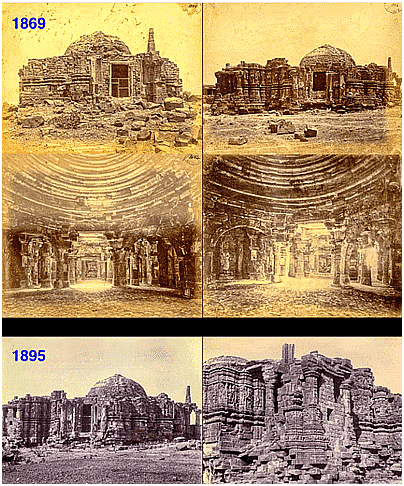
- 19th-century ruined Somnath temple: British official and scholar, Alexander Burnes surveyed the site in 1830 and stated that the temple was converted into a Muslim structure (mosque) with an arch.
- Present temple: Temple has a ‘Kailash Maha Meru Prasad’ form. The new temple is intricately carved, with pillared mandapa and 212 relief panels.
Madhika Language

Overview
The Madhika language is predominantly spoken by the Chakaliya community. Unlike many languages, it lacks a script. Despite its resemblance to Kannada, it can perplex listeners due to its diverse linguistic influences.
- Madhika is a fusion of Telugu, Tulu, Kannada, and Malayalam, with a significant impact from Havyaka Kannada, an ancient form of Kannada. Unfortunately, it is on the verge of extinction as the younger generation favors Malayalam over Madhika.
Key Points about the Chakaliya Community
- The Chakaliya community, originally nomadic, were devoted worshippers of Thiruvenkatramana and Mariamma. Centuries ago, they migrated from the hilly regions of Karnataka to northern Malabar.
- Initially recognized as a Scheduled Tribe, they were later categorized as Scheduled Caste in Kerala. References to this community can be found in the book "Caste and Tribes of Southern India."
Government Initiative to Preserve Languages
- The Government of India has launched the "Scheme for Protection and Preservation of Endangered Languages of India" (SPPEL). This scheme aims to safeguard languages spoken by fewer than 10,000 people, referred to as endangered languages.
- The Central Institute of Indian Languages (CIIL), based in Mysore, plays a vital role in this initiative. Established in 1969 as a subordinate office of the Ministry of Education, CIIL is tasked with formulating and executing language policies.
- It conducts research in language analysis, pedagogy, technology, and language usage in society.
Parakram Divas
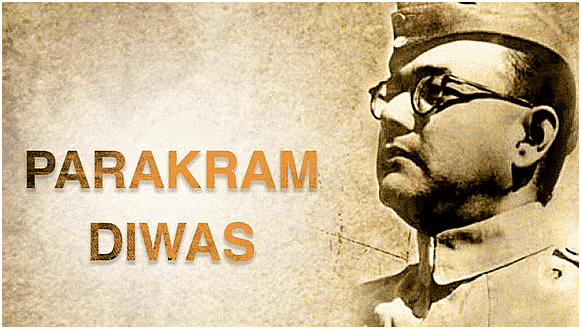
Parakram Diwas, observed annually on January 23, commemorates the birth anniversary of Subhas Chandra Bose, a prominent freedom fighter renowned as 'Netaji'.
- This year marks his 127th birth anniversary. The celebration of Parakram Diwas is aimed at fostering fearlessness and patriotism, particularly among the youth, encouraging them to confront challenges with resilience.
Key Points about Subhas Chandra Bose
- Birth and Early Life: Born on January 23, 1897, in Cuttack, Orissa, Bose exhibited early signs of leadership and dedication to the Indian nationalist cause.
- Political Involvement: After passing the civil service examination in 1920, Bose resigned from his position the following year to join the Indian independence movement, becoming an influential leader within the Indian National Congress.
- Leadership and Ideological Conflicts: Bose served as the president of the Indian National Congress for two consecutive terms before resigning due to ideological differences with Mahatma Gandhi.
- Formation of Forward Bloc: In 1939, Bose established the Forward Bloc, aiming to unite various anti-British forces in India.
- Global Endeavors: Amidst the Second World War, Bose sought alliances with nations like the Soviet Union, Germany, and Japan to launch an offensive against British colonial rule in India.
- Indian National Army and Azad Hind Government: With Japanese support, Bose reorganized and led the Indian National Army, comprised of Indian prisoners-of-war and plantation workers from Southeast Asia. Additionally, he established the Azad Hind Government in exile, leading military campaigns against the British in India.
|
164 videos|800 docs|1157 tests
|
FAQs on History, Art & Culture: February 2024 Current Affairs - General Test Preparation for CUET UG - CUET Commerce
| 1. What is the significance of Maratha Military Landscapes in Indian history? |  |
| 2. Who were Savitri Bai Phule and Rani Velu Nachiyar, and why are they important figures in history? |  |
| 3. What is the Kadamba Inscription, and what does it reveal about ancient Indian civilization? |  |
| 4. What is the significance of Vadnagar as the oldest living city of India? |  |
| 5. Why is Chittorgarh Fort considered a symbol of Rajput valor and resilience? |  |




















